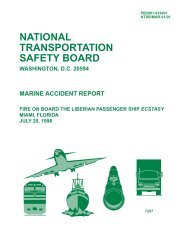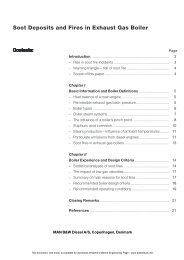download it here - Martin's Marine Engineering Page
download it here - Martin's Marine Engineering Page
download it here - Martin's Marine Engineering Page
You also want an ePaper? Increase the reach of your titles
YUMPU automatically turns print PDFs into web optimized ePapers that Google loves.
International ShippingCarrier of World TradePromoting technical co-operation to ensure the efficiency, safetyand environmental performance of the global shipping industryIMOWORLDMARITIMEDAY2006This document, and more, is available for <strong>download</strong> at <strong>Martin's</strong> <strong>Marine</strong> <strong>Engineering</strong> <strong>Page</strong> - www.dieselduck.net
IMO WorldMar<strong>it</strong>ime DayThe theme of the2006 Un<strong>it</strong>ed NationsInternational Mar<strong>it</strong>imeOrganization (IMO)World Mar<strong>it</strong>ime Day is‘Technical Co-operation:IMO’s response to the2005 world summ<strong>it</strong>’.The following information hasbeen prepared by the RoundTable of international shippingassociations – BIMCO, INTERCARGO,INTERNATIONAL CHAMBER OFSHIPPING/INTERNATIONAL SHIPPINGFEDERATION and INTERTANKO.It is also supported by thenational shipowners’ associationsof Australia, Austria, Belgium,Brazil, Bulgaria, Canada, Chile,China, Croatia, Cyprus, Denmark,Finland, France, Germany, Greece,Hong Kong - China, Iceland,India, Ireland, Isle of Man, Italy,Japan, Korea, Kuwa<strong>it</strong>, Liberia,Luxembourg, Mexico, Netherlands,New Zealand, Norway, Pakistan,Philippines, Singapore, Spain,Sweden, Sw<strong>it</strong>zerland, Turkey, Un<strong>it</strong>edKingdom and the Un<strong>it</strong>ed States.For more information about theshipping industry see:www.shippingfacts.comInternational Shipping – Carrier of World TradeThe international shipping industry is responsible for the carriage of90% of world trade and is the life blood of the global economy.W<strong>it</strong>hout shipping, <strong>it</strong> would simply not be possible to conductintercontinental trade, the bulk transport of raw materials or the import/export of affordable food and manufactured goods – half the world wouldstarve and the other half would freeze!35,00030,00025,00020,00015,000Billion tonne milesGrowth in world seaborne tradeSource: Fearnleys95 96 97 98 99 00 01 02 03 04 05* 06**estimatedShips are technically sophisticated, high value assets (the largest hi-techvessels can cost over US $150 million to build) and the operation of merchantships generates an estimated annual income approaching US$500 billion infreight rates, representing about 5% of the total global economy.It is the availabil<strong>it</strong>y, low cost and efficiency of mar<strong>it</strong>ime transport that hasmade possible the large shift towards industrial production in Asia, which has inlarge part been responsible for recent improvements in global living standards.World trade continues to grow and the international shipping industry hasresponded to demand for <strong>it</strong>s services. Recently, the industry has enjoyedwhat has become the longest sustained period of buoyant markets w<strong>it</strong>hinliving memory. Shipping markets are cyclical and notoriously volatile, andtoday’s unprecedented markets are unlikely to continue for ever. However,virtually all sectors of the industry have benef<strong>it</strong>ed from the recent globalshipping boom.This document, and more, is available for <strong>download</strong> at <strong>Martin's</strong> <strong>Marine</strong> <strong>Engineering</strong> <strong>Page</strong> - www.dieselduck.net
Global Regulation for a Global IndustryShipping is an international industry which depends upon a global regulatoryframework to operate efficiently.International Mar<strong>it</strong>imeOrganization (IMO) insession in LondonShipping enjoys a relatively level ‘playing field’ between mar<strong>it</strong>ime nations, as well ashealthy compet<strong>it</strong>ion between individual shipping companies, of which t<strong>here</strong> are around10,000 involved in international trades, operating about 50,000 ships.Shipping is highly regulated at the global level,notably by the Un<strong>it</strong>ed Nations International Mar<strong>it</strong>imeOrganization (IMO), which is responsible for safety oflife at sea, mar<strong>it</strong>ime secur<strong>it</strong>y and the protection ofthe marine environment. In add<strong>it</strong>ion, the InternationalLabour Organization (ILO) establishes standards ofemployment and working cond<strong>it</strong>ions for seafarers.It is v<strong>it</strong>al that regulations on matters such asconstruction standards, navigational rules and crewqualifications are common to all ships in internationaltrade. When a ship sails from Brisbane to BuenosAires, the same rules need to apply at both ends of thevoyage. The alternative would be a web of conflictingnational regulations, resulting in market distortions andadministrative confusion that would compromise theefficiency of world trade.The level of ratification and enforcement ofIMO Conventions is very high in comparison w<strong>it</strong>hinternational rules adopted for land based industries.For example, the provisions of the Safety of Life at SeaConvention (SOLAS) and the International Conventionfor the Prevention of Pollution from Ships (MARPOL)have been implemented by virtually every mar<strong>it</strong>imecountry. IMO regulations are enforced on a global basisand nations have the power to detain foreign ships inport if they do not conform to international rules.ILO has also adopted the Mar<strong>it</strong>ime Labour Convention(MLC) which is shortly expected to be implemented on aglobal basis, to provide a level playing field w<strong>it</strong>h regardto seafarers’ employment standards.The safety record of the industry and <strong>it</strong>s environmentalperformance are impressive (see graphs, right).National and regional policy makers occasionallyquestion the efficiency of the international regulatoryregime under which shipping operates. But whenconsideration is given to the difficulties involved insecuring international agreement on complex technicalrequirements, IMO is a model of efficiency.This document, and more, is available for <strong>download</strong> at <strong>Martin's</strong> <strong>Marine</strong> <strong>Engineering</strong> <strong>Page</strong> - www.dieselduck.net
Technical Co-operationand the IMO Voluntary MemberState Aud<strong>it</strong> Scheme3002502001501005015010050700600500400300200100Shipping’s performanceTotal losses by number(ships over 100 gt)Number of ships01997 1998 1999 2000 2001 2002 2003 2004 2005A ‘loss’ refers to ships damaged beyond economic repairSource: Lloyd’s Register FairplayQuant<strong>it</strong>y of oil spilled (tonnes)Thousand tonnes031171993 1996 1999 2002 2005Source: International Tanker Owners’ Pollution Federation Lim<strong>it</strong>edComparison of CO2 emissions betweendifferent transport modesCO2 (grams per tonne/kilometre)heavytruckw<strong>it</strong>htrailer13980cargovessel2,000-8,000dwtcargovesselover8,000dwt0Source: NTM (Swedish Network for Transport and the Environment)67airfreight747-4001,200 kmflightIt is probably not overstating the case to suggest thatthe recent adoption of the IMO Voluntary Member StateAud<strong>it</strong> Scheme will prove to be the most significantIMO regulatory milestone of the decade. For thefirst time, mar<strong>it</strong>ime administrations will be subject toexternal aud<strong>it</strong> of how effectively they implement andenforce IMO safety and pollution prevention regulations.Moreover, the aud<strong>it</strong>ors will act under the auspices ofIMO, using specially trained experts nominated by otherIMO member states.Crucially, the results of the aud<strong>it</strong>s shouldallow resources from IMO’s TechnicalCo-operation programme to be bettertargeted at mar<strong>it</strong>ime administrations in lessdeveloped countries.It will take time for the aud<strong>it</strong>s to be conducted andfor the actions that follow to bear fru<strong>it</strong>. However,the development is significant, not only because allflag states can learn from their peer group, but moreparticularly because most of the small number of substandardships that still trade, at risk to their crewsand the environment and w<strong>it</strong>h an unfair advantage overtheir compet<strong>it</strong>ors, are concentrated in just a handful ofpoorly performing flag states.The Round Table organisations have been strongsupporters of the development of the IMO Scheme andhave been impressed by the pragmatic way in whichgovernments have addressed understandable concernsabout sovereignty. The IMO aud<strong>it</strong> is thus voluntary, asis the Code on the Implementation of Mandatory IMOInstruments on which the aud<strong>it</strong>s will be based. Inpractice, however, and importantly, <strong>it</strong> will be v<strong>it</strong>al forany reputable mar<strong>it</strong>ime administration to subm<strong>it</strong> to anaud<strong>it</strong> in order to maintain <strong>it</strong>s reputation and to satisfy<strong>it</strong>s shipping company clients.Meanwhile, as a complement to the IMO Scheme, theRound Table of international shipping associationshas updated <strong>it</strong>s Shipping Industry Guidelines on FlagState Performance. The Guidelines are accompaniedby the industry’s Flag State Performance Table, whichcontinues to be updated on an annual basis(see www.marisec.org/flag-performance).This document, and more, is available for <strong>download</strong> at <strong>Martin's</strong> <strong>Marine</strong> <strong>Engineering</strong> <strong>Page</strong> - www.dieselduck.net
The low costs of mar<strong>it</strong>ime transportDue to continuous improvements in technology and efficiency,mar<strong>it</strong>ime transport costs are very compet<strong>it</strong>ive.•The typical cost to a consumer in theUn<strong>it</strong>ed States of transporting crude oilfrom the Middle East, in terms of thepurchase price of gasoline at the pump, isless than one US cent per l<strong>it</strong>re.•The typical cost of transporting a tonneof iron ore from Australia to Europe by seais about US $10.• The typical cost of transporting a20 foot container from Asia to Europecarrying over 20 tonnes of cargo is aboutthe same as the economy airfare for asingle passenger on the same journey.Typical Ocean Freight Costs (Asia-US or Asia-Europe)Typical ShippingUn<strong>it</strong> Shelf Price CostsTV Set 1 un<strong>it</strong> $700.00 $10.00Bulk shipping costshave increased byonly 70% in the last50 years.US retail prices haverisen by almost 700%!Different sectors as a percentageof total number of ships in theworld fleet 1 Jan 20067%38%DVD/CD Player 1 un<strong>it</strong> $200.00 $1.5014%25%4%12%VacuumCleaner 1 un<strong>it</strong> $150.00 $1.00ScotchWhisky Bottle $50.00 $0.15Coffee 1 kg $15.00 $0.15TankersBulk carriersContainer shipsGeneral cargo shipsPassenger shipsOtherSource: Lloyd’s Register FairplayBiscu<strong>it</strong>s Tin $3.00 $0.05Beer Can $1.00 $0.01This document, and more, is available for <strong>download</strong> at <strong>Martin's</strong> <strong>Marine</strong> <strong>Engineering</strong> <strong>Page</strong> - www.dieselduck.net
Different types of shipsin the world fleetContainer Ships carry most ofthe world’s manufactured goodsand products, usually on scheduledliner services. The latest generationof container ships can carry theequivalent of 10,000 heavy trucks.Bulk Carriers are the workhorses of the fleet, transportingraw materials such as iron ore, coaland foodstuffs, and are identifiableby the hatches raised above decklevel which cover the large cargoholds. The largest bulk carriers cantransport enough grain to feed nearlyfour million people for a month.Tankers transport crude oil,chemicals and petroleum products.More than 70% of the world’s oceangoing tankers now have double hulls.The largest tankers can carry over300,000 tonnes of oil, enough toheat an entire c<strong>it</strong>y for a year.Other Ships include car carriers(shown <strong>here</strong>), gas carriers, heavylift vessels and ships supporting theoffshore oil industry. T<strong>here</strong> are alsoa large number of smaller generalcargo ships.Ferries and Passenger ShipsFerries usually perform shorterjourneys for a mix of passengers,cars and commercial vehicles.Many of these ships are Ro-Ro(roll on-roll off). The numberof luxury cruise ships has alsoexpanded greatly in recent years.The Round Table ofinternational shippingassociationsPublished by Mar<strong>it</strong>ime International Secretariat Services LtdTel +44 20 7417 8844E-mail post@marisec.orgFor an electronic version see:www.shippingfacts.comThis document, and more, is available for <strong>download</strong> at <strong>Martin's</strong> <strong>Marine</strong> <strong>Engineering</strong> <strong>Page</strong> - www.dieselduck.net
















